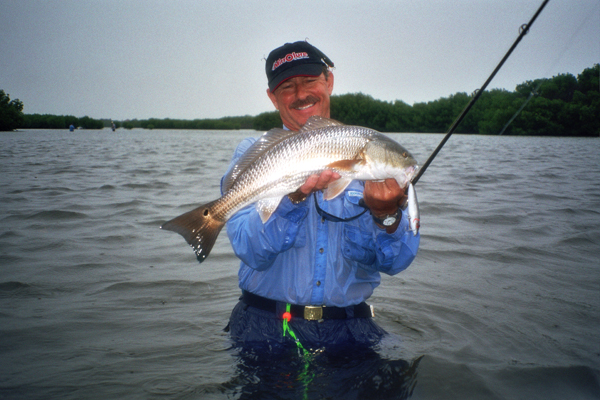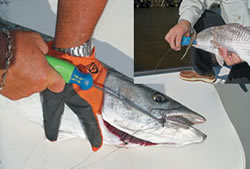October 03, 2012
By David Brown
Make release easy on the fish—and on yourself.
 Be careful when releasing species, such as this redfish, that were caught with hard baits. Treble hooks are much easier to unhook with help from release tools.
Be careful when releasing species, such as this redfish, that were caught with hard baits. Treble hooks are much easier to unhook with help from release tools.
Slimy hands shouldn't be your only concern when handling fish. Responsible angling means exercising caution to protect yourself and any non-keepers. Here are some tips on releasing fish right.
Release tools are convenient for quickly flipping non-keepers or nuisance fish off the hook. Most have curved tips that latch onto the bend of your hook. Inverting the hook allows the fish to fall off with the pressure of its own weight. A little shake is all that's usually needed. For lightly hooked fish, a pair of needlenose or narrow-tip pliers will suffice. Make things easier by crimping down hook barbs.
But there are times when you have to grab the fish to do the job. First dampen your hands in sea water. Hold the fish as gently as possible to avoid rubbing away the protective slime coating. The slime helps the fish move through the water and repels infections and parasites.
The surest way to avoid slime depletion is to minimize your contact points. With seatrout and many others, the skin just inside the base of the gill flaps provides a firm gripping spot that won't squeeze anything vital. Pinch this area lightly and let the fish's belly rest naturally against the heel of your hand. Most of the time, the fish won't move until you release the grip.
Some fish have natural “handles” such as the bony jaws of a snook or tarpon. The center point of the lower jaw in both fish has a pronounced nub that fits nicely under the thumb. With these, or any other, never grip a fish's lower jaw and then turn it horizontally (usually for a photo). This unnatural angle can dislocate the fish's jaw and severely hinder feeding. For horizontal poses, support the fish's stern by sliding your hand under its tail. You don't want to lift a heavy fish vertically with a jaw grip, either—the weight of its organs will likely cause fatal damage inside. Best bet, for both large snook and tarpon, is to leave them in the water, control them with the jaw grip, and ease the hook out.

Getting the hooks out of a fish in a fast and timely manner means good conservation.
|
Certainly, protecting the fish is important, but don't neglect your own safety. Many fish such as sharks, mackerels, bluefish and snappers delight in biting their captors. Other hazards include the edgy gill plates of snook, snapper and sea bass; sharp spines on sheepshead (dorsal) and catfish (dorsal and pectoral); and the retractable spikes on a cobia's back.
For some fish, simply holding them in a certain position causes temporary paralysis. The spell may be brief, but it's often enough to remove a hook and get your hands clear of danger.
Snook, for example, are highly combative and tend to flip and thrash while you're trying to remove the hook. Control your fish by gripping the snook from the belly side behind the pectoral fins, laying it on its side in your palm and gently squeezing. In this position, the snook will rest nearly motionless, even as you relax your grip. Without all the normal commotion of an agitated linesider, you can safely remove the hook and release the fish to fight again.
Other examples include the jack crevalle: With thumb and forefinger, squeeze the dark spots on either side of the gill covers and the yellow bruiser freezes.
Often, the ideal grip is one that simply keeps your hands away from the danger spots. When in doubt, reach from behind a fish's head and grip over the gill plates.
Elongated fish like king mackerel, barracuda and sharks present an underestimated danger as their overall length enables them to swing into biting range when held only by the tail. Sharks are particularly dangerous in this respect because their cartilaginous frame allows them the flexibility of a snake. Your best bet with long fish is to first place your main grip behind the head and then grab the tail so a boatmate can remove hooks or lures while you minimize movement.
When working alone, or if a big fish's struggling becomes too risky, simply grip the line or leader at a safe distance, hold the fish over an open cooler or fish box, clip the rig and drop the troublemaker into the ice. You can remove the hooks after your fish goes to sleep. For non-keepers, try to keep the fish in the water and clip the leader as close to the hook as possible. Non-stainless steel hooks are optimal, as they dissolve out of a fish's jaw shortly after release.
FS
First published in Florida Sportsman magazine, December, 2005.
Click Here to Have Florida Sportsman Magazine Delivered to Your Door.

